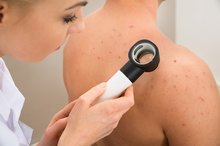What does fact checked mean?
At Healthfully, we strive to deliver objective content that is accurate and up-to-date. Our team periodically reviews articles in order to ensure content quality. The sources cited below consist of evidence from peer-reviewed journals, prominent medical organizations, academic associations, and government data.
The information contained on this site is for informational purposes only, and should not be used as a substitute for the advice of a professional health care provider. Please check with the appropriate physician regarding health questions and concerns. Although we strive to deliver accurate and up-to-date information, no guarantee to that effect is made.
Causes of Dark Spots on Your Legs
Dark spots on the legs can develop for many reasons. Spots can be as harmless as freckles or a sign or symptom of a serious disease. If you have any concerns about dark spots that develop on your legs or other parts of your body, it’s best to consult with your family physician or a dermatologist.
Age Spots
Age spots, also known as liver spots or solar lentigo, usually appear after years of sun exposure. Health-Cares.net reports they’re most common in people older than 55 and can occur almost anywhere on the body, especially areas that have seen a lot of sun or suffered from sunburns 1. The spots are nothing but collections of skin pigment that have accumulated in the top layer of skin and can be removed in a number of ways, such as by laser treatment, freezing, acids or skin sanding.
- Age spots, also known as liver spots or solar lentigo, usually appear after years of sun exposure.
- Health-Cares.net reports they’re most common in people older than 55 and can occur almost anywhere on the body, especially areas that have seen a lot of sun or suffered from sunburns 1.
Freckles
Brown Spots on the Legs of a Diabetic
Learn More
Freckles are usually found on the face and arms, but they can appear on legs, too. These small brown spots are harmless and can be a product of genetics or sun exposure. They’re most common in fair-skinned people. The Cleveland Clinic notes that since freckles are almost always harmless, there’s no reason to treat them.
- Freckles are usually found on the face and arms, but they can appear on legs, too.
- The Cleveland Clinic notes that since freckles are almost always harmless, there’s no reason to treat them.
Diabetic Dermopathy
People with diabetes sometimes develop light brown or red scaly patches on the front of the legs. The Cleveland Clinic reports that this skin condition, known as diabetic dermopathy, is caused by changes in the small blood vessels of diabetics. These skin spots don’t hurt, blister or itch, and usually don’t require any medical treatment.
Moles
Reddish-Brown Spots on the Skin
Learn More
The Cleveland Clinic describes moles as growths on the skin that occur when skin cells grow in clusters, rather than being spread throughout the skin. The growths are usually black or brown, normally appear in the first 20 years of life and can develop anywhere on the skin. According to the Cleveland Clinic, most moles are benign and no cause for concern. However, if a mole changes over time, becomes asymmetrical, has a ragged border or variations in color, it’s time to see a dermatologist.
- The Cleveland Clinic describes moles as growths on the skin that occur when skin cells grow in clusters, rather than being spread throughout the skin.
Melanoma
Melanoma is a type of skin cancer that can occur anywhere on the body, but MayoClinic.com reports that in women, it most often appears on the lower legs 3. Melanoma can appear as a large brownish spot with darker speckles. Another sign of melanoma is a mole that bleeds or changes in color, size or feel. Melanoma can affect people of all skin tones. See a doctor if you have any signs of this disease.
- Melanoma is a type of skin cancer that can occur anywhere on the body, but MayoClinic.com reports that in women, it most often appears on the lower legs 3.
- Melanoma can affect people of all skin tones.
Related Articles
References
- Cleveland Clinic: Foot and Skin Related Complications of Diabetes
- MayoClinic.com: Skin Cancer
- American Academy of Dermatology. Variety of Options Available to Treat Pigmentation Problems. February 5, 2013. https://www.aad.org/media/news-releases/variety-of-options-available-to-treat-pigmentation-problems
- Tomecki J, Woodhouse G. Common Benign Growths. Cleveland Clinic Center for Continuing Education. http://www.clevelandclinicmeded.com/medicalpubs/diseasemanagement/dermatology/common-benign-growths/
- Scarcella G, Dethlefsen MW, Nielsen MCE. Treatment of solar lentigines using a combination of picosecond laser and biophotonic treatment. Clin Case Rep. 2018;6(9):1868-1870. doi:10.1002/ccr3.1749
- Scherer D, Kumar R. Genetics of pigmentation in skin cancer--a review. Mutat Res. 2010;705(2):141-53. doi:10.1016/j.mrrev.2010.06.002
- Bastiaens M, Hoefnagel J, Westendorp R, Vermeer BJ, Bouwes bavinck JN. Solar lentigines are strongly related to sun exposure in contrast to ephelides. Pigment Cell Res. 2004;17(3):225-9. doi:10.1111/j.1600-0749.2004.00131.x
- Davis EC, Callender VD. Postinflammatory hyperpigmentation: a review of the epidemiology, clinical features, and treatment options in skin of color. J Clin Aesthet Dermatol. 2010;3(7):20-31.
- George AO, Shittu OB, Enwerem E, Wachtel M, Kuti O. The incidence of lower mid-trunk hyperpigmentation (linea nigra) is affected by sex hormone levels. J Natl Med Assoc. 2005;97(5):685-8.
- Al-saif FM, Baqays AA, Alsaif HF, Alhumidi AA. Erythromelanosis follicularis faciei et colli with reticulated hyperpigmentation of the extremities. Clin Case Rep. 2017;5(10):1576-1579. doi:10.1002/ccr3.1095
- Dereure O. Drug-induced skin pigmentation. Epidemiology, diagnosis and treatment. Am J Clin Dermatol. 2001;2(4):253-62. doi:10.2165/00128071-200102040-00006
- Ammoury A, Michaud S, Paul C, et al. Photodistribution of blue-gray hyperpigmentation after amiodarone treatment: molecular characterization of amiodarone in the skin. Arch Dermatol. 2008;144(1):92-6. doi:10.1001/archdermatol.2007.25
- Jain A, Gupta N. Multifocal Bullous Fixed Drug Erruption Due To Phenytoin: A Lesson Learned! J Clin Diagn Res. 2015;9(12):OD04-5. doi:10.7860/JCDR/2015/15464.6908
- Mccarty M, Rosso JQ. Chronic administration of oral trimethoprim-sulfamethoxazole for acne vulgaris. J Clin Aesthet Dermatol. 2011;4(8):58-66.
- Massinde A, Ntubika S, Magoma M. Extensive hyperpigmentation during pregnancy: a case report. J Med Case Rep. 2011;5:464. doi:10.1186/1752-1947-5-464
- Sarkar SB, Sarkar S, Ghosh S, Bandyopadhyay S. Addison's disease. Contemp Clin Dent. 2012;3(4):484-6. doi:10.4103/0976-237X.107450
- Lause M, Kamboj A, Fernandez faith E. Dermatologic manifestations of endocrine disorders. Transl Pediatr. 2017;6(4):300-312. doi:10.21037/tp.2017.09.08
- Enguita FJ, Leitão AL. Hydroquinone: environmental pollution, toxicity, and microbial answers. Biomed Res Int. 2013;2013:542168. doi:10.1155/2013/542168
- Arora P, Sarkar R, Garg VK, Arya L. Lasers for treatment of melasma and post-inflammatory hyperpigmentation. J Cutan Aesthet Surg. 2012;5(2):93-103. doi:10.4103/0974-2077.99436
- Prohaska J, Badri T. Cryotherapy. StatPearls Publishing. 2019.
- Schalka S. New data on hyperpigmentation disorders. J Eur Acad Dermatol Venereol. 2017;31 Suppl 5:18-21. doi:10.1111/jdv.14411
- American Academy of Dermatology. Variety of Options Available to Treat Pigmentation Problems. February 5, 2013.
- Tomecki J, Woodhouse G. Common Benign Growths. Cleveland Clinic Center for Continuing Education.
Writer Bio
Carol Ochs is an award-winning writer in the Washington, D.C. area. During 17 years with The Associated Press she covered health, medical and sports stories as a writer, editor and producer. She has written for the health section of "The Washington Post," a Fairfax County stewardship publication and a biopharmaceutical newsletter. Ochs has a Bachelor of Science in journalism from Ohio University, Athens.









